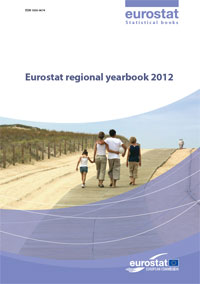 |
EUROSTAT REGIONAL YEARBOOK 2012
Eurostat, 2012, 220 pages
|
http://epp.eurostat.ec.europa.eu/cache/ITY_OFFPUB/KS-HA-12-001/EN/KS-HA-12-001-EN.PDF
Статистическая информация является важным инструментом
для понимания и количественной оценки влияния политических решений
на определенной территории или регионе. Региональный ежегодник Евростата
2012 представляет детальную картину, касающиеся широкого круга статистических
тем в различных регионах 27 государств-членов Европейского союза
(ЕС) и Европейской ассоциации свободной торговли, а также стран-кандидатов.
Каждая глава издания представляет статистическую информацию в виде
карт, графиков и таблиц и сопровождается описанием основных выводов,
источников данных и политического контекста. Региональные показатели
приведены для 11 следующих областей: экономики, населения, здравоохранения,
образования, рынка труда, структурной статистики предприятий, туризма,
информационного общества, сельского хозяйства, транспорта, науки,
технологий и инноваций. Кроме того, в издание включены три специальных
главы: это взгляд на европейские города и прибрежных районы, а заканчивается
публикация описанием методов, используемых для идентификации сельских
и городских районах.
Contents
Foreword
Acknowledgements
INTRODUCTION
EU statistics on regions and cities
The NUTS classification
The use of NUTS in this publication
Coverage and timeliness
More information about regional statistics
More information about statistics on cities
Eurostat online data codes
Statistics explained
EU policies
Europe 2020 strategy
Regional policies.
Urban policies
1 ECONOMY
Main statistical findings
Regional GDP per inhabitant
A more detailed regional analysis
Major regional differences within countries
Convergence
Overall increase in convergence within the EU
Private household income: 2008 results
Data sources and availability
Comparisons between where people work and where they live
Purchasing power parities
Dispersion of regional GDP per inhabitant
Further information
Context
2 POPULATION
Main statistical findings
Population size and density
Population change
Decline in the fertility rate
Life expectancy gaps between men and women
Demographic ageing
Data sources and availability
Further information
Context
3 Health
Main statistical findings
Causes of death
Diseases of the circulatory system
Cancer (malignant neoplasms)
Diseases of the respiratory system
Hospital beds
Healthcare professionals
Data sources and availability
Causes of death
Healthcare
Further information
Context
4 EDUCATION
Main statistical findings
Participation of 4-year-olds in education
Students aged 17 in education
Early leavers from education and training
Students in tertiary education
Tertiary educational attainment
Data sources and availability
Further information
Context
Diversity of national education systems
Education and training 2020
5 LABOUR MARKET
Main statistical findings
Employment rates
Employment rates for men and women
Employment rates for older workers
Unemployment rates
Changes in unemployment rates
Long-term unemployment
Youth unemployment
Data sources and availability
Further information
Context
6 STRUCTURAL BUSINESS STATISTICS
Main statistical findings
Industrial and services specialisation
Detailed specialisation within the non-financial business economy
Range of specialisation
Business concentration
Data sources and availability
Further information
Context
7 TOURISM
Main statistical findings
Number of overnight stays
Recent trends in tourism
Camping
Share of inbound tourism
Top 20 tourist regions in the EU-27 visited by foreign tourists
Most popular regions
Tourism intensity
Average length of stay
Accommodation capacity
Data sources and availability
Further information
Context
Tourism policy
8 INFORMATION SOCIETY
Main statistical findings
Access to information and communication technologies
Regular use of the Internet
E-commerce by individuals
Data sources and availability
Further information
Context
9 AGRICULTURE
Main statistical findings
Economic significance of agriculture
Agricultural labour productivity
Livestock density
Cows and cows’ milk production
Cereals
Potatoes
Vineyards
Data sources and availability
Further information
Context
10 TRANSPORT
Main statistical findings
Motorway networks
Stock of passenger cars, buses and coaches
Stock of road freight vehicles
Air transport
Data sources and availability
Further information
Context
11 SCIENCE, TECHNOLOGY AND INNOVATION
Main statistical findings
Research and development intensity
Researchers
Human resources in science and technology
Employment in high-tech sectors
Patents
Data sources and availability
Further information
Context
12 FOCUS ON EUROPEAN CITIES
Main statistical findings
Cities and urban areas
Old-age dependency
Students in tertiary education
The labour market: perception of job hunting
The labour market: unemployment
Perception of financial difficulties
Air pollution — ozone
Data sources and availability
Further information
Context
Urban development — future cohesion policy
13 FOCUS ON COASTAL REGIONS
Main statistical findings
EU coastal regions and their maritime basins
Maritime freight transport
Maritime passenger transport
Cruise passengers
Tourism in coastal regions
Data sources and availability
Coastal regions
Maritime transport
Tourism
Context
Maritime and coastal policies
Maritime transport and ports
Coastal tourism
14 FOCUS ON TERRITORIAL TYPOLOGIES
Typologies
Cluster types
Contiguous cells and filling gaps in the cluster typology
Degree of urbanisation typology for LAU level 2 areas — an area
typology
Urban–rural typology for NUTS level 3 regions — a regional typology
Summary table: names and alternative names
Main statistical findings
Share of population by type of territory
Share of land area by type of territory
Data sources and availability
Further information
Context
Annex 1 — Classification of territorial
units for statistics
European Union: NUTS level 2 regions
EFTA countries: statistical regions at level 2
Candidate countries: statistical regions at level 2
Annex 2 — Cities participating in the
Urban Audit data collection
European Union: Urban Audit cities
EFTA countries: Urban Audit cities
Candidate countries: Urban Audit cities
|

